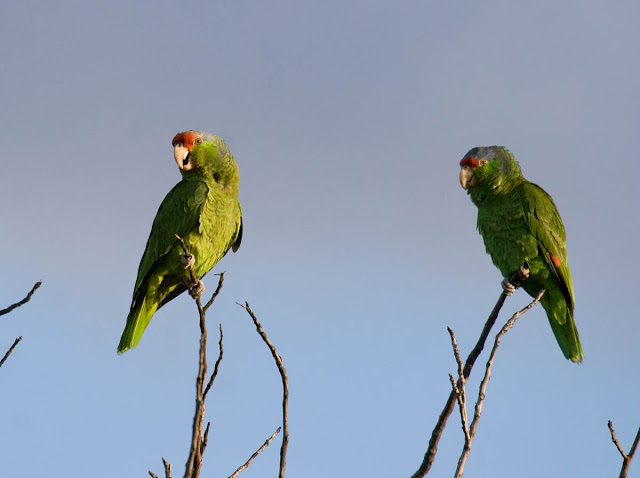Most parrots are found right in downtown. There are large night-time roosts at Point Loma and El Cajon. At dusk birds return after being dispersed throughout the area all day. But I live in the North County about 35 miles north of downtown. Parrots are far less common here.
Back in February 2014 I saw my first large Amazon parrot (parrots in the genus Amazona). I got some photos and determined they were likely Lilac-crowned Parrots (Amazona finschi). I know a bit more about their identification now, and still think I identified them correctly.
Both the Red-crowned and Lilac-crowned Parrots are endangered. A primary reason for their decline is deforestation in Mexico. And, although importation of parrots from Mexico into the US is illegal, these birds are still caught for the pet trade inside Mexico. Thus, after 40 years or more of escapes and breeding in the wild, the Red-crowned Parrot is more numerous in southern California and Texas than they are in NE Mexico where they are native and endangered. See this article from the Christian Science Monitor.
 |
| Red-crowned Parrot (left) and hybrid(?) (right). San Diego, California. May 21, 2016. Greg Gillson. |
Of the two birds, neither showed the full bright crown of Red-crowned, but neither did they match Lilac-crowned. The bird on the left (above) has a darker eye. That indicates a young bird, so the restricted red on the crown is expected. The right bird has a definite white eyering, so that is the strongest indication of Red-crowned, as the eyering on Lilac-crowned is blue. And at least one of the birds clearly gave descending whistles among their other grating and screeching calls. That matches Red-crowned and not the rising whistle of Lilac-crowned.
 |
| Red-crowned Parrot or hybrid with Lilac-crowned Parrot? The only thing worse to a birder than an introduced bird is a hybrid! |
On the other hand, the outer vanes of the base of the outer tail feathers show blue on Lilac-crowned. And the tail is longer. Neither of those is a match on the above bird. But that restricted dark red forehead. I could be talked into this bird being a hybrid.
 |
| Red-crowned Parrot |
Now that I know to listen for the upslurred or downslurred whistles, I'll feel better about identifying birds as they fly over, or are perched high in a palm against overcast coastal morning skies.
Interestingly, many birders do not pay much attention to introduced or escaped birds. After all, only wild, free-flying birds are "countable" by the major birding organizations. Escaped cage birds are not countable, and populations that escape and breed are only considered "established" if they have been present for many years (10-20 years) and their population is not dependent upon continued releases in order to maintain itself. On the other hand, birders can't keep ignoring the growing populations of feral birds in California, Texas, and Florida--they are "real" birds eating food and competing for resources whether or not they are "countable" on a birder's list.
Still, there's more information on identification of parrots on the local parrot cage bird website than in the birding field guides. That doesn't seem right, either.

No comments:
Post a Comment
I really want to hear from you! I've changed settings (again) in order to try to make commenting easier without opening it up to spammers. Please note, however, that comments to posts older than 14 days will be moderated. Thank you.